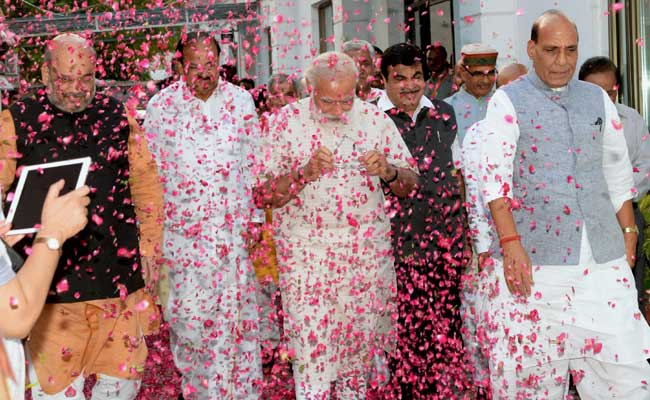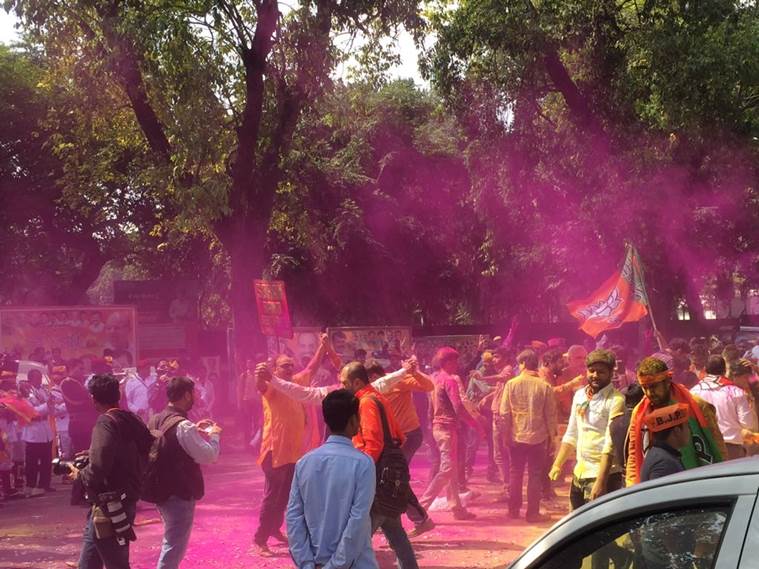Saffron BJP return to power after 14 years in Uttar Pradesh

 NEW DELHI : In a remarkable turn of fortunes in Uttar Pradesh, the Bharatiya Janata Party is set to return to power after 14 years as it has swept the state by winning over 300 seats. This is the party’s best performance so far in the state, considering that this was only the second time it won with a clear majority.
NEW DELHI : In a remarkable turn of fortunes in Uttar Pradesh, the Bharatiya Janata Party is set to return to power after 14 years as it has swept the state by winning over 300 seats. This is the party’s best performance so far in the state, considering that this was only the second time it won with a clear majority.
The last time it crossed the 2/3rd mark was in 1991, at the height of Ram Janam Bhoomi movement, when it won 221 seats.The Narendra Modi-led Bharatiya Janata Party is likely headed for a clean sweep in Uttar Pradesh. Data at 10 am shows the ruling party may win close to 285 seats in the 403 member state assembly.
The five factors that likely led to the huge win for BJP in Uttar Pradesh. Modi wave Prime Minister Narendra Modi’s immense popularity with the masses has likely worked in BJP’s favour. The Prime Minister is seen as the face of the landmark demonetisation decision, which seems to have gone down well with masses.
Analysts said voters believe the PM is sincere in his promise to crack down on black money. The PM actively participated in the campaign trail and promised to put development on fast track.
Demonetisation Despite the hardships faced by people, the poor and the middle class believe that the decision hit rich tax evaders hard. The common perception in people is that it is a good move and will help the country in the long run.
Support from SCs While detailed data is not available, analysts believe the scheduled castes (except the Jatavs who tend to vote for BSP) likely voted for the BJP as they feel marginalised under a Samajwadi Party rule. RSS support The RSS mobilised its cadre in full force in UP, unlike during the Bihar 2015 upset, when the RSS chief Mohan Bhagwat’s statement on reservations was thought to have worked against the BJP.
Reports suggest the RSS also played a role in playing peacemaker between warring factions of the state BJP unit and tried to persuade dissatisfied candidates who did not win tickets. Yadav family infighting The infighting in the Yadav family, with party patriarch Mulayam Singh Yadav siding with brother Shivpal Yadav and against his son, CM Akhilesh, likely hurt the SP’s prospects. Yadav senior also stayed away from campaigning. In the second last phase, Mulayam’s second wife Sadhna attacked Akhilesh in an interview that was seen as hurting the CM’s image.
Either the EVMs did not accept votes other than BJP, or the votes of other parties have gone to BJP in the EVMs, says BSP chief Mayawati. Most votes in Muslim majority constituencies have gone to BJP, makes it evident that voting machines were manipulated, she adds. I have written to Election Commission in this regard, people no more have faith in EVM machines, Mayawati further says.
This overwhelming endorsement of PM Modi’s vision is a leap forward in India taking its rightful place in the world stage, says Union Minister Narendra Modi.The previous best showing by BJP in UP was in 1991, at the height of Ram Janam Bhoomi movement, when it got majority on its own winning 221 seats out of 425 in an undivided state.
Riding on ‘TsuNamo’, Bharatiya Janata Party (BJP) today won with a two-third majority in the country’s most populous state of Uttar Pradesh, garnering about 40 per cent of the total votes polled.
Its closest contender, the ruling Samajwadi Party (SP), and Mayawati-led Bahujan Samaj Party (BSP) have got about 22 per cent votes each. Congress, which fought the UP election in alliance with the Samajwadi Party, bagged only six per cent of the votes.
On the other hand, BJP polled about 40 per cent of votes. Even though this is two per cent lower than the 42 per cent votes BJP had got in the 2014 Lok Sabha elections, the party has swept the Uttar Pradesh election.
However, in retrospect, it is clear that Samajwadi Party, BSP and Congress could have together pipped BJP in UP. On March 9, the day exit polls were declared, SP chief Akhilesh Yadav indicated that his party was ready to join hands with BSP. He had exhorted all “secular forces” to come together to keep the “communal” BJP away from power in case there was a hung Assembly.
It goes to the credit of Akhilesh Yadav and election strategist Prashant Kishor for SP and Congress forming an alliance. However, the story today would have been different had BSP too joined the SP-Congress bandwagon. RJD supremo had even floated the idea of BSP joining the two parties but it did not materialise.
SP, BSP and Congress should have learned from the Bihar experiment where the ruling Janata Dal (U), RJD and Congress joined hands to convincingly defeat BJP in the 2015 Assembly election.As in the case of RJD in Bihar, Yadavs and Muslims are SP’s votebanks in UP. It had come back to power in 2012 with their solid backing. While the Yadavs constitute 15 per cent of the state’s total votes, Muslims form 18 per cent.
2012 UP ELECTION RESULTS
In the 2012 elections, SP had registered its highest vote share of 29.15 per cent of the total votes polled, winning 224 of the total 403 seats.SP’s traditional rival BSP had polled 25.91 per cent of the total votes cast, winning 80 seats. The Congress, which had fought elections under the leadership of Rahul Gandhi, won 28 seats, polling 11.63 per cent of votes.
On the other hand, BJP managed to win just 47 seats, polling only 15 per cent of total votes cast.Hence, together SP, BSP and Congress could have given BJP a run for its money.
SP’s anti-incumbency would have been offset by the presence of BSP. The Muslim votes would not have got split. They would have gone to the grand alliance in Bihar. Brahmins and a large section of Dalits would also have chosen this mahagathbandhan over BJP.
BIHAR EXPERIMENT
The template had already been cast in Bihar where the Yadavs and Muslims – RJD’s votebanks – polled aggressively in favour of the mahagathbandhan. In Bihar, while Yadavs constitute 14 per cent the voters, Muslims are 17 per cent. Kurmis, Bihar Chief Minister Nitish Kumar’s castemen who comprise 4 per cent of the voters, too voted for the grand alliance.
The experiment was successful. The RJD and JD(U), which had fielded 101 candidates each on the total 243 constituencies, won 80 and 71 seats respectively. Congress, which fielded 41 candidates on 41 seats, won 27. Total, they won a whopping 178 of the 243 seats.
While RJD polled 18.4 per cent of the votes cast, JD(U) polled 16.8 and Congress 6.7 per cent. On the other hand, BJP failed to match the grand alliance’s combined strength. It won just 53 of the 157 seats it contested. Strike rate-wise, its performance was poorest than all the three parties of the mahagathbandhan. However, on individual level, it polled the highest percentage of votes – 24.4 per cent.
UP SCENARIO
Had SP, BSP, Congress and Ajit Singh-led RLD (winning 2 per cent of votes) come together, they could have garnered 52 per cent of votes – a whopping 12 per cent more than what BJP got. This could have translated into votes, edging out BJP as the winner.
But Prime Minister Narendra Modi and BJP got the advantage of a divided Opposition house. In the absence of an Opposition unity, Modi was successful in consolidating votes in BJP’s favour.

